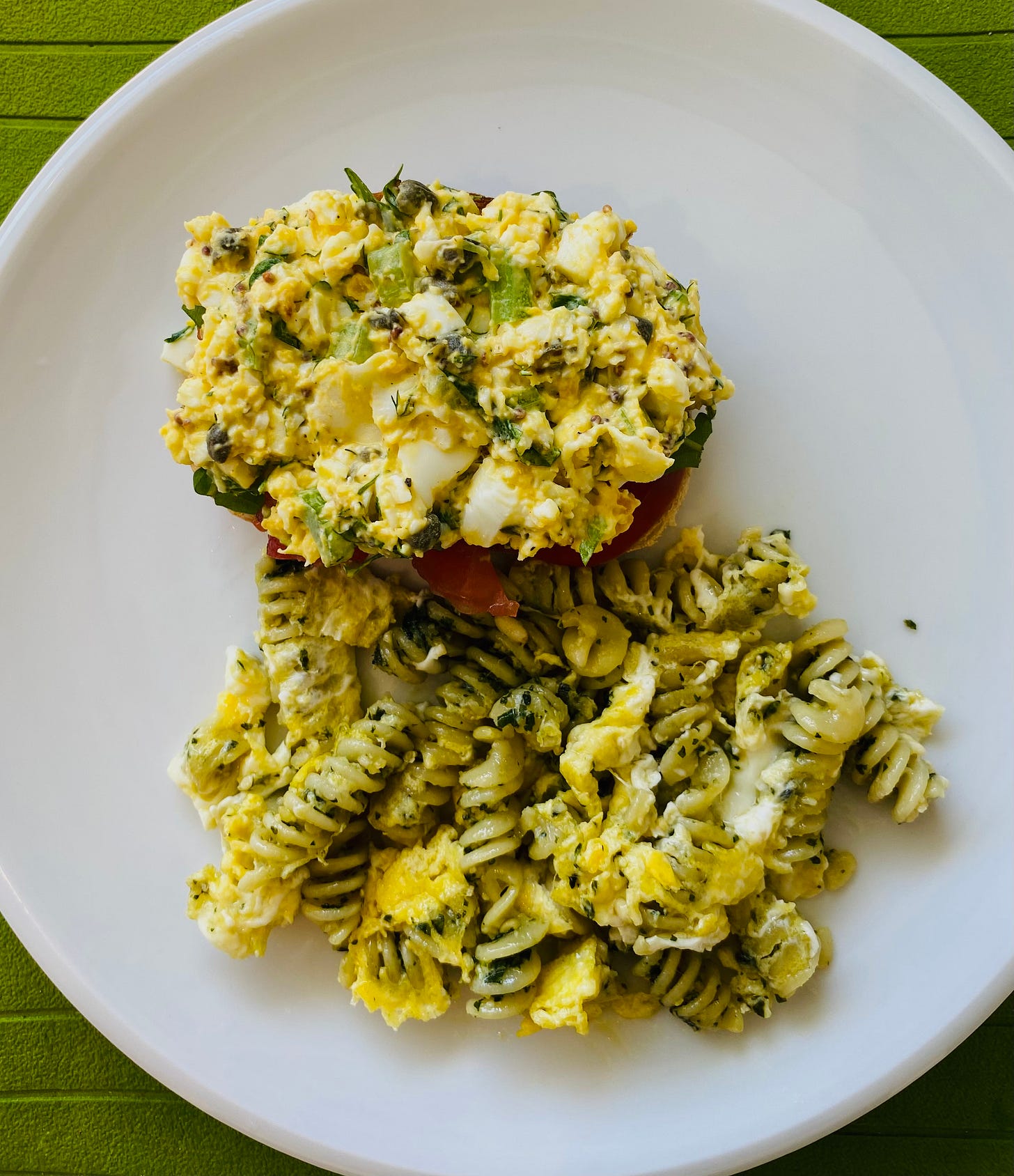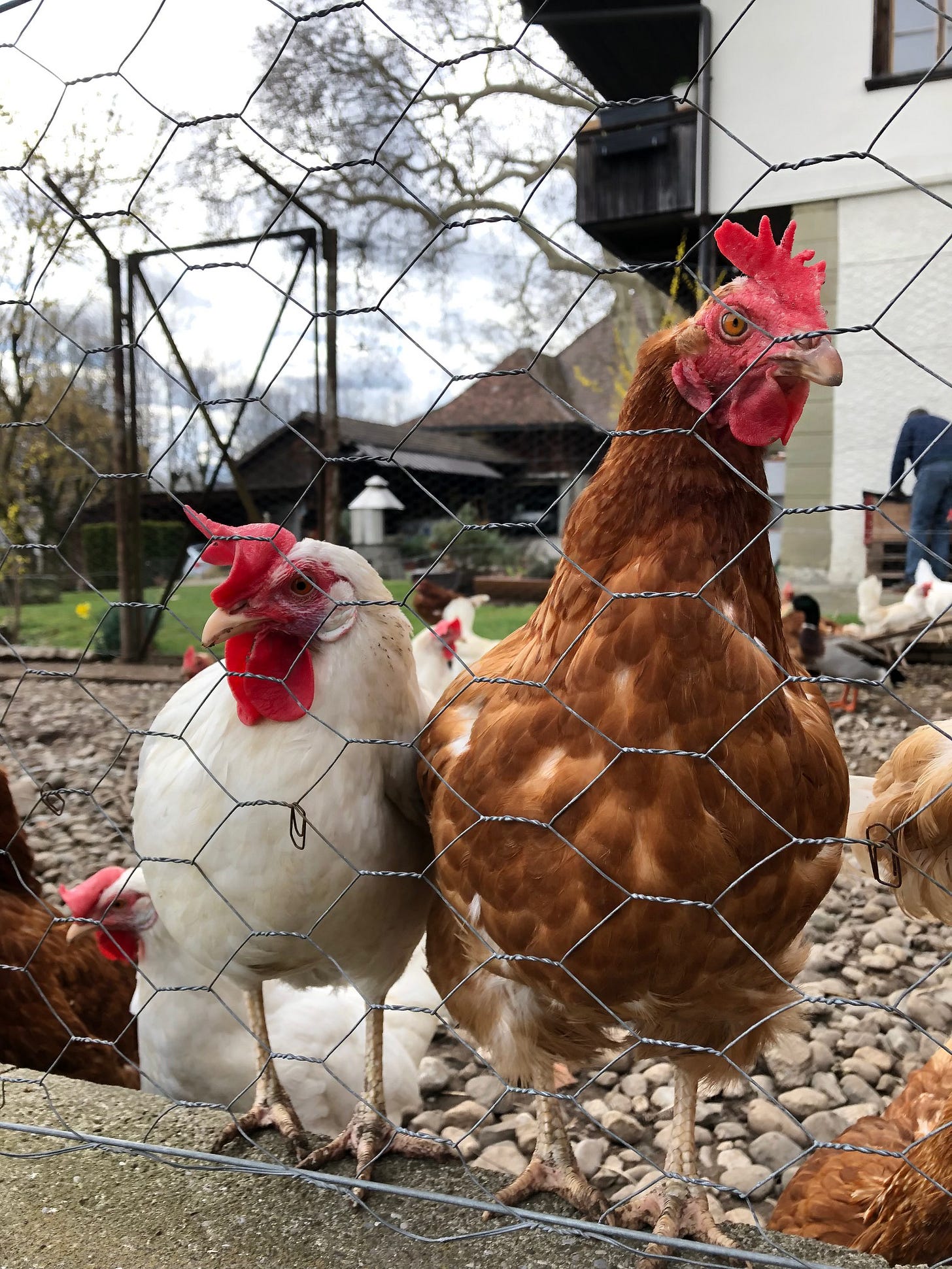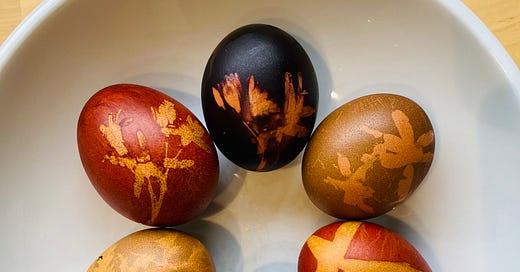It’s egg season! Last weekend, Jews around the world ate eggs during the Passover seder to honor the annual cycle of rebirth and renewal. This weekend, Christians will celebrate Easter by going to church, wearing fancy Easter outfits, singing alleluias, feasting together, and, of course, dyeing Easter eggs.
Even if we aren’t Jewish or Christian—or religious—eggs are important to our culture. They symbolize springtime, new life, fresh beginnings, and awakening to our potential.
Or they used to, anyway (she said darkly). In recent years eggs have taken on a less-savory meaning in the US.
Penny-Wise and Pound-Foolish
As we are well aware, eggs have become political lately. High egg prices are a synecdoche1 for the terrible burden that inflation has placed on American families. Eggs hit a peak average price of almost $5 per dozen in January. There has even been rationing. The Trader Joe’s in our son’s DC neighborhood limits customers to a dozen eggs per trip, for example. We worry about eggs’ scarcity and high cost and are looking for someone to blame. High egg prices have been credited with helping to elect Trump.
Which is frustrating, because high egg prices were caused not by Democrats but by bird flu. Farmers had to cull millions of birds to combat bird flu, which constricted the egg supply and thus raised the price. But, as the linked article notes, healthy chicken populations are beginning to rebound, and as a result egg prices have begun to drop. Because Americans were upset about having to temporarily pay a couple dollars more per week for eggs, we now have a president whose tariffs have caused the stock market to lose trillions of dollars in value, which has gutted our retirement savings, will worsen inflation, and will likely lead to a recession.
I don’t mean to pick only on Republicans, though, because Democrats can be penny-wise and pound-foolish about eggs too. Take the New York Times, which once again seems to have no clue about how ordinary families live. The headline of an article last week claimed that eggs are so expensive that Americans are resorting to dyeing potatoes. Intrigued, I eagerly opened the article, hoping to find photos of gaily-colored potatoes and perhaps a recipe, only to discover that the title was clickbait except for a stray allusion (with no corroborating link) to “Videos on how to dye . . . potatoes . . . circulat[ing] on social media.” Is anyone actually dyeing potatoes because they can’t afford eggs? Unlikely.
Much of the article discussed a food-blogger who, because “eggs are way too expensive right now,” makes her own Easter eggs out of “peanut butter, almond flour and maple syrup . . . [dipped] in melted white chocolate tinted with blue spirulina powder and matcha.” Is it smart budgeting to refuse to buy eggs because of the cost and instead to buy almond flour and maple syrup—to say nothing of blue spirulina powder (whatever that is) and matcha? Also unlikely!
In fact it makes little sense to avoid eggs because they cost more than they did before bird flu. Eggs are an affordable source of healthy protein and a great way to stretch otherwise unappealing leftovers into a tasty meal. Pasta Mama, for example, repurposes leftover pasta: Just sauté some garlic and dried oregano in olive oil or butter, add in your pasta straight from the fridge (pesto pasta is especially yummy) and heat through, scramble two or three eggs, pour them into the pan, and cook until done. Top with grated cheese, and Bob’s your uncle.

Another cheap, quick, and satisfying dish is what my husband affectionately calls Trash Omelette.
Trash Omelette
Scramble four eggs with about 1/4c of whole milk.
Pull out any aging herbs and vegetables from the fridge. Shriveled mushrooms, wilted spinach, that celery stalk no one wants, a detumescent carrot—they might be terrible in a salad, but they are terrific in the Trash Omelette. Chop everything up and sauté in olive oil with some garlic, salt, and pepper.
Remove the veggies to a bowl, add a bit more olive oil or butter to the pan, and pour the eggs into the pan (no need to wash the pan first).
Cook until the eggs are almost set, and then top with the vegetables. Cover the pan to heat the vegetables through.
Finally, do you have cheese “of second freshness”? Cut off and discard the moldy bits, grate up the rest, strew the cheese over the vegetables, and cover the pan and heat just until the cheese melts. Quarter the omelette and serve immediately.
All the Longer It Takes, All the Longer It Takes
The internet is full of tips for boiling eggs so they are easy to peel. I’ve tried everything, and only one trick works: Use old eggs.

As this explainer informs us, fresh eggs are difficult to peel because the albumen of fresh eggs has a low pH, which causes it to bond with the eggshell. But older eggs have a higher pH and thus don’t bond as much. In addition, some of the liquid in older eggs will have evaporated through the pores in the shells during the weeks they sat in our fridge. This causes the eggs to shrink back from the shell, which also makes them easier to peel.
So this is another egg metaphor, and a useful lesson: All good things come to those who wait—or, as our dad used to say to my brother and me when we were kids and getting antsy, All the longer it takes, all the longer it takes.
Elegant Egg Salad
Ingredients:
6 large, old-ish eggs (at least two weeks old)
1tsp baking soda
1 rib of celery—the darkest green you can find for maximum flavor—finely minced
1/4c capers, coarsely chopped
1/4c Italian flat-leaf parsley, leaves only, coarsely chopped
2T fresh dill, leaves only, coarsely chopped
1T Dijon mustard (the kind with whole seeds)
1/4c (or more, to taste) mayonnaise
lots of freshly-ground black pepper and salt to taste
Method:
Place the eggs in a pot with the baking soda and cover with cold water. (The baking soda will help prevent the egg white from sticking to the shell.) Put the pot on high heat and bring to a rolling boil. Cover the pot, remove from heat, and let sit exactly nine minutes.2
Drain the eggs under running, cold water, and then put them in an ice bath. Chill for at least half an hour.
Laboriously peel the eggs and drop them into a medium bowl. Even if you did everything right, this step will be a hassle! (It helps to listen to a podcast while you work.3) Mush the peeled eggs up with a fork.
Add in all the other ingredients, mix, and taste and adjust seasonings if necessary.
Let’s Reclaim the Egg
I think we need to take eggs back from politics and return to wholesome egg metaphors from days of yore. Let’s make the egg symbolize family togetherness and the circle of life again. To that end, here are some fun egg-related activities we can do with our kids:
Dye eggs using my dad’s cool method: Drop a tiny bit of oil on the surface of the blue dye. Dye an egg in the blue first, allow it to dry, wipe it off, and then dip it in the yellow or red. You will get eggs that are marbled green and yellow, or purple and red. Now try reversing the order of colors, or try it with the oil on a different color. Kids love to experiment with mixing the colors.
Enlist your kids in turning your Easter eggs into egg salad. (Kids enjoy mushing up the ingredients!) For a kid-friendly version of my recipe, omit the parsley and substitute a diced dill pickle for the capers.
Host a debate over which came first, the chicken or the egg. Your kids will be excited to inform you that of course the egg came first, because dinosaurs laid eggs. Allow the afternoon to evolve into an impromptu class where your children teach you all the facts they know about dinosaurs.
Finally, take a walk in nature to look for nests, eggs, and songbirds. Offer a prize to anyone who finds a robin’s egg.

How about you, readers? What are your favorite recipes featuring eggs? Are you dyeing eggs (or potatoes?) this year? Please share your thoughts in the comments!
The Tidbit
Some droll Alberta egg farmers have put together a list of silly jokes about chickens and eggs. Here are two good ones to share with kids:
Q: How can you drop an egg six feet without breaking it? A: Drop it seven feet. It won’t break for the first six!
Knock knock! Who’s there? Chicken. Chicken who? Chicken your pockets—your keys might be in there.
This website has a treasure-trove of “Why did the chicken cross the road?” jokes. Some of my favorite answers are:
Because the road was too long to walk around it.
Because the road betrayed it first. (Another version is, “No one knows, but the road will have its revenge!”)
To show the armadillo that it was actually possible.
Or metonymy? I can never keep these two terms straight.
I adapted this method from Mark Bittman, How to Cook Everything Vegetarian. You may be surprised at how short the cooking time is, but I urge you not to cook the eggs any longer than this. Nine minutes of cooking will set the yolks without making them dry and powdery. A shorter cooking time also prevents that icky gray ring around the yolks and the repellent sulfurous smell that hard-cooked eggs tend to get.





Peeling eggs! Like you, I struggled for years trying to figure it out. I used to cook the eggs by the same method as you, cold water start. And like you, older eggs were better... but still often a pain. But one day I noticed peeled eggs sold in the grocery store, and figured there is no way they don't have a fool-proof method, probably mechanized.
And Shazam! https://www.youtube.com/watch?v=F7HBxBCaUMI
It's a fun video. The two key points: Cold egg goes directly into hot water or steam. Then after your preferred cooking time, drop into cold water for 1 minute-- not any longer. When the egg is just warm, the shell will just slip right off! It's practically a miracle.
Like the trash omlete, I will often make a lasagna the same way. Clean out the fridge before groceries shopping.